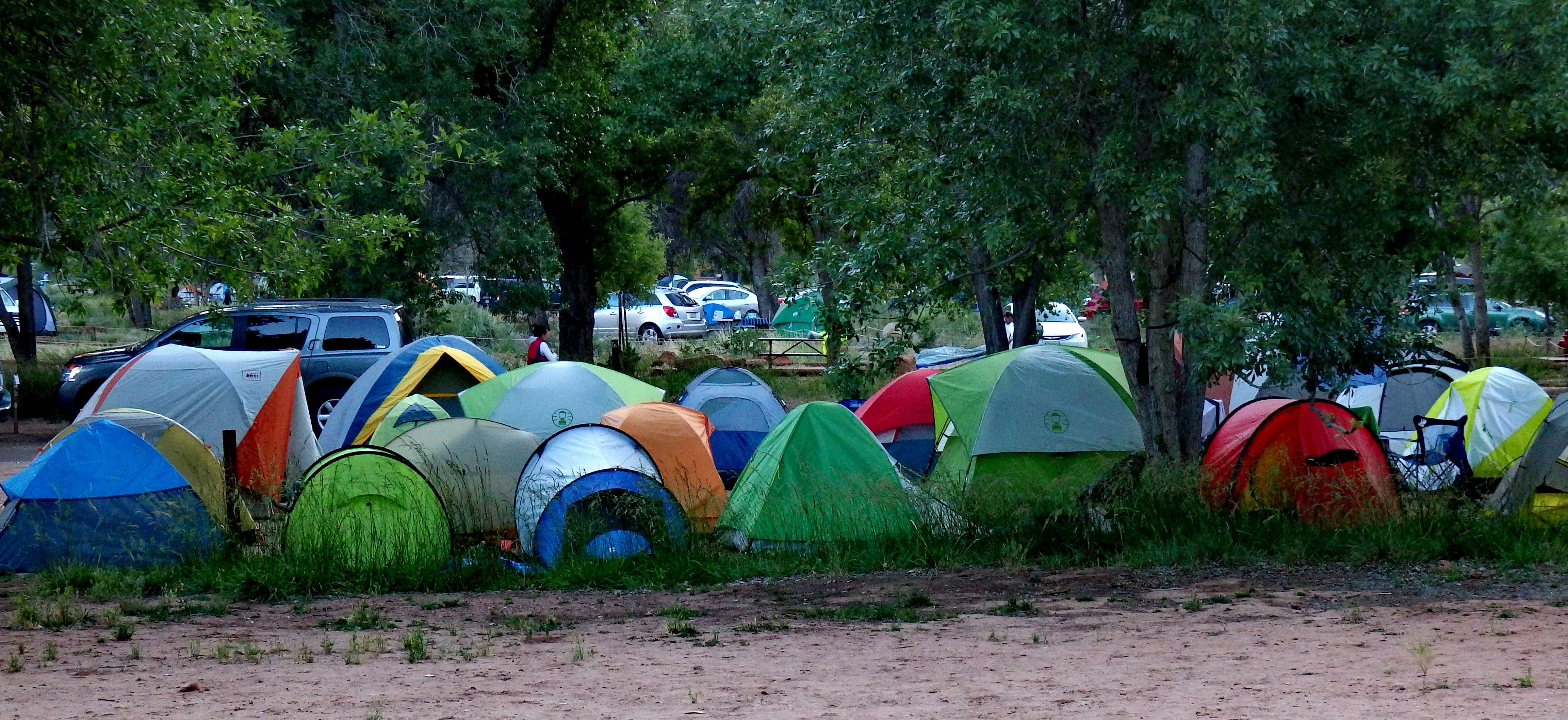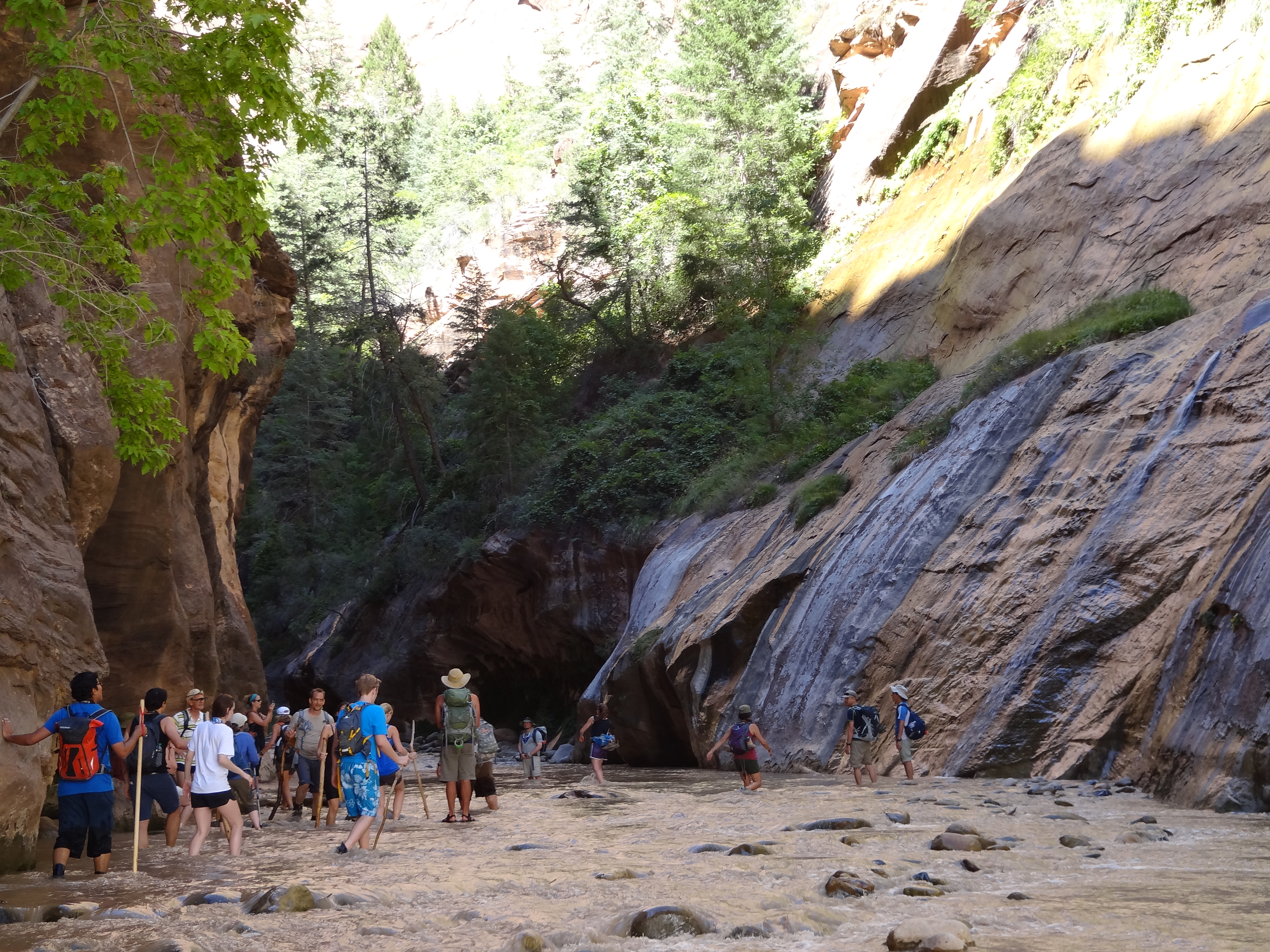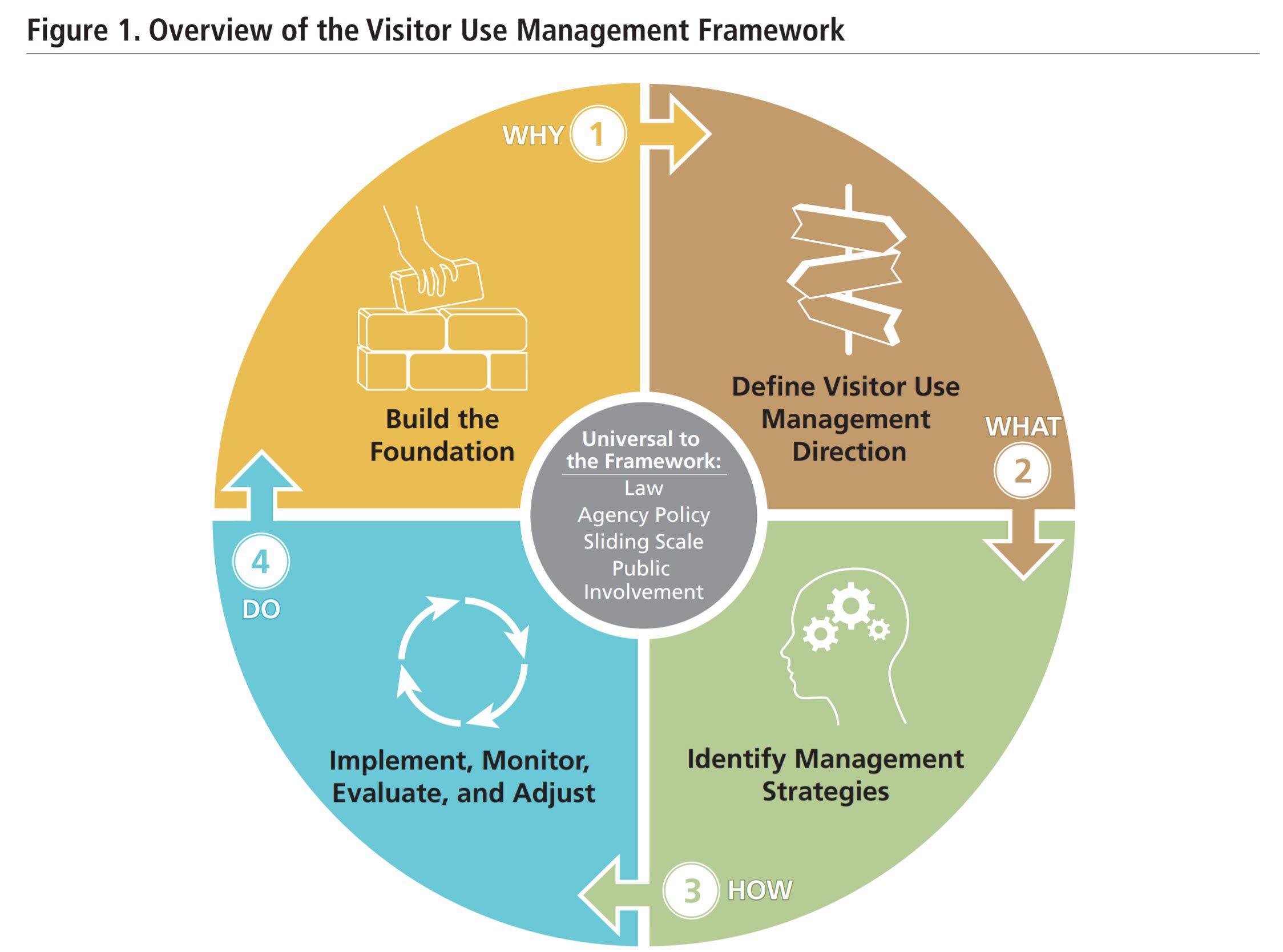Visitor Use Management Overview
This module introduces Visitor Use Management Online Training

Estimated Time:
35 Minutes
Objectives
In this module you'll learn how to:
- Explain VUM broader role within federal land management
- Define the four elements of VUM
- Find resources for your specific agency or bureau
Why Manage Recreation?
Outdoor recreation is fundamental to American culture. Every year, more and more people travel to public lands and waters to pursue a growing variety of recreational activities. To continue to benefit from the opportunities created by expanding recreational use, this nationwide trend requires that all of us—visitors, managers, and citizens—adopt more effective ways to manage visitor access and use that ensure these special places, and the benefits they generate, persist for this and future generations.
What is the Visitor Use Management Framework?
The Visitor Use Management Framework (the framework) is a process designed for federal managers to collaboratively develop, implement, and monitor strategies and actions to provide sustainable access to lands and waters. The intent, and ultimate desired outcome, is to provide high quality visitor experiences, while protecting natural and cultural resources. Responsive and effective visitor use management requires managers to:
- Identify desired conditions for resources,visitor experiences and opportunities, and facilities and services;
- Gain an understanding of how visitor use influences achievement of those goals; and
- Commit to active / adaptive management and monitoring of visitor use to meet those goals.
The framework can be incorporated into existing federal agency planning and decision-making processes and is applicable across a wide spectrum of situations that vary in complexity and spatial extent from site-specific to large-scale planning efforts. The framework is a legally defensible and transparent planning and decision-making process that:
- Integrates applicable laws and policy requirements;
- Provides sound rationale upon which to base management decisions; and
- Facilitates adaptive management.

What is VUM Framework?
“Everybody needs beauty as well as bread, places to play in and pray in, where Nature may heal and cheer and give strength to body and soul alike." - John Muir,1912
Every year, people across the country flock to federally managed lands and waters for a variety of recreational purposes. Some are visiting an area for the first time, while others are returning to places they visit year after year. Some visitors are alone, and others visit with friends and family. On any given day, visitors are planning their trips, others are immersed in a long visit, and some are heading home and reflecting on their shared memories of time well spent. Recreation is a core element of American culture and a vital thread in the fabric of society. It allows people to connect with their natural and cultural heritage, be healthier in mind and body, enhance the bonds between family and friends, contribute to the economic vitality of communities, and be inspired and rejuvenated. Further, these opportunities allow people to better understand and care for resources and federal lands and waters, creating citizen stewards who want to support sustained management of our collective heritage.
The last decade has been an exciting time with many initiatives, such as the White House’s America’s Great Outdoors and Every Kid in a Park and the Department of the Interior’s America’s Youth in the Great Outdoors, which encourage visitor access and connections to federally managed lands and waters. In particular, these initiatives encourage federal agencies to be responsive to an increasingly diverse public that has changing interests and expectations. With this encouragement of access, there is a corresponding need to heighten managers’ thoughtful approaches to managing visitor use.
The Interagency Visitor Use Management Council (the council) was chartered in 2011 to develop best practices for visitor use management on federally managed lands and waters. Visitor use management is the proactive and adaptive process for managing characteristics of visitor use and the natural and managerial setting using a variety of strategies and tools to achieve and maintain desired resource conditions and visitor experiences. Simply put, it means managing use well to provide sustainable recreation.
This Visitor Use Management Framework (the framework) is intended to provide managers of federal lands and waters guidance regarding a common approach to visitor use management. More specifically, this framework provides the analytical elements necessary to address visitor use management opportunities and issues, consistent with applicable law, within existing agency management processes. The elements of the framework are combined with the appropriate procedural components (e.g., public involvement and environmental and cultural resource analysis) for the particular project being conducted. By using this framework, managers collaboratively develop long-term strategies for providing access, connecting visitors to key visitor experiences, protecting resources, and managing visitor use. The decisions made within the framework are professional judgments informed by the best available science, staff expertise, and public input.
The concepts presented in this framework are not new; the framework is the product of an evolution of earlier efforts, modified to reflect lessons learned. It follows all of the council agencies’ planning principles and illustrates how to specifically address visitor use management. It is consistent with previous efforts, such as the Limits of Acceptable Change process and the Visitor Experience and Resource Protection Framework. In particular, one of the goals of this framework is to avoid the limitations of previous frameworks. Past frameworks were perceived to apply only in certain situations or to specific federal agencies, to be overly complex and costly, as stand-alone processes that were separate from other agency planning efforts, and as reactive. See appendix A for a brief summary of the history of visitor use management concepts and frameworks.
This framework will enhance consistency in visitor use management on federally managed lands and waters, since it will be used by all agencies. The elements of this framework are broadly applicable to all visitor use management opportunities and issues. The framework is applicable across a wide spectrum of situations that vary in spatial extent and complexity, from site-specific decisions to large-scale comprehensive management plans. More specifically, the framework may be used as part of a general or comprehensive planning effort, which typically provides overall guidance on desired conditions, appropriate uses, and general management strategies for different areas within a unit. The framework may also be used to guide project-level planning and management, which typically define actions for specific areas. This framework may also be used across a series of projects that build on each other and may be applied to internally driven activities (e.g., analyzing a management action), as well as externally driven activities (e.g., a permit request or an action by another agency).
All federal agency actions are subject to a variety of procedural requirements, including the National Environmental Policy Act (NEPA) and the National Historic Preservation Act. However, each agency has specific policies and procedures for implementing and documenting these requirements. This requires planners to be familiar with and apply their specific agency NEPA and National Historic Preservation Act direction and any other procedural planning rules when using this framework. Chapter 4 highlights some of these commonalities and differences by agency.

The Interagency Visitor Use Management Council’s vision statement: Providing a unified voice for excellence in visitor use management on our nation’s federally managed lands and waters to sustain resources and quality visitor experiences. See the council’s website: visitorusemanagement.nps.gov/.
Overview and Purpose
The purpose of the framework is to provide cohesive guidance on the major elements for analyzing and managing visitor use on federally managed lands and waters. It is also intended to provide a legally defensible, transparent decisionmaking process that meets law and policy requirements, ensures agency accountability, and provides sound rationale upon which to base management decisions and actions. In short, the framework provides a professional, comprehensive approach to visitor use management on federal lands and waters.
This framework is designed to be highly flexible and adaptable to local situations and needs. Of particular importance is the notion of a sliding scale of analysis, whereby the investment of time, money, and other resources in the analysis is commensurate with the complexity of the project and the consequences of the decision. For some projects, one person might work through the framework to a decision in a few hours; other projects might require multiple years of work by large teams. Another important concept is applying the framework proactively to determine which management actions are necessary to meet management objectives before unacceptable impacts occur. Monitoring data can help refine the understanding about which actions are necessary to maintain and/or achieve desired conditions and improve the understanding and use of indicators and thresholds. This framework and a subsequent guidebook on indicators, thresholds, and monitoring emphasize the importance of setting thresholds at acceptable levels of impact and responding to trends in changing conditions as identified by monitoring.
Organization of the Framework
This framework is organized into five chapters. The current chapter, chapter 1, gives an overview of the framework and a summary of background information. Chapter 2 introduces the concept of the sliding scale of analysis and describes, generally, how it applies to all steps of the framework. Chapter 3 provides more detailed descriptions of each element and its steps within the framework (see figure1). Chapter 4 provides guidance on integrating the framework into agency planning processes and procedural requirements; each agency may apply the framework in a slightly different way to conform to its planning guidance. Appendix A offers a brief history and limitations of previous visitor use management frameworks. A hypothetical example of applying the framework is included in appendix B. A glossary of key terms follows appendix C, which is a blank decision support tool.

This document is not a “cookbook” of exactly how to implement each step of the framework; the context of each project guides the application of the framework. In addition, each agency’s planning processes and procedural requirements are considered during implementation of the framework. Application of the framework should include creativity and flexibility to ensure meaningful visitor use management projects and decisions. Additional “how to” guidance on several of the framework steps is included in subsequent council guidebooks. See the council’s website for more information visitorusemanagement.nps.gov
Visitor use refers to human presence in an area for recreational purposes, including education, interpretation, inspiration, and physical and mental health. The Interagency Visitor Use Management Council considers visitor use management and recreation management as synonymous concepts.
More
Element Two
Define Visitor Use Management Direction: What conditions are we trying to achieve?
Learn MoreElement Three
Identify Management Strategies: How will visitor use be managed to achieve desired conditions?
Learn MoreElement Four
Implement, Monitor, Evaluate, and Adjust: Are we making progress towards desired conditions?
Learn More








